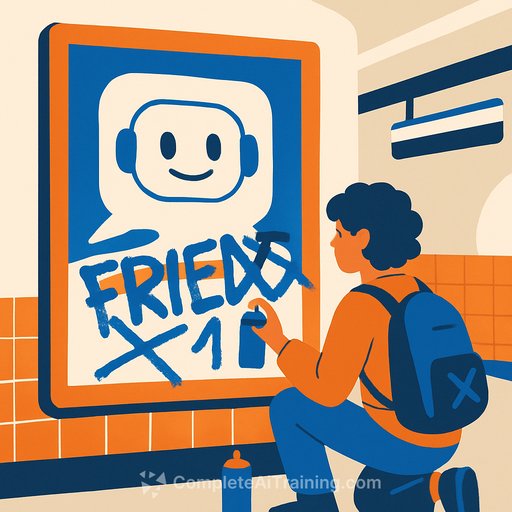Friend AI's Subway Backlash: What Rage-Bait Marketing Actually Buys You
Friend, an AI companion brand, blanketed NYC subways with minimalist billboards suggesting an AI "friend" beats human connection. Lines like "I'll never bail on dinner plans" and "I'll binge the entire series with you" were met with swift, angry graffiti from commuters.
Critics called out the campaign for exploiting loneliness and ignoring surveillance concerns. Online and offline, the reaction became the story.
What actually happened
The campaign pushed provocation on purpose. The company's 22-year-old CEO, Avi Schiffmann, even hinted the wide white space was left to invite reactions-exactly what the ads received, in ink.
Vandalism included messages like "Go make real friends. This is surveillance," and "AI wouldn't care if you lived or died." The result: virality built on contempt, not affinity.
Why it backfired with everyday riders
- It poked at pain, not aspiration. Loneliness is real. Mocking it reads as predatory, not helpful.
- The cultural mood matters. Public anxiety about data, tracking, and synthetic connection is high. The ads dismissed it.
- OOH is a community space. If your message feels anti-human, the "community" will answer-right on your creative.
- Attention without trust is a sugar high. You can score reach while burning long-term goodwill and category acceptance.
Does outrage work?
Short-term? Yes-spikes in mentions, shares, and press. Long-term? Only if you convert that attention into trust and utility. That's the gap most "rage bait" misses.
If your product promise clashes with human values (connection, privacy, dignity), awareness fuels rejection. You don't want to be famous for the reason people won't buy.
A smarter playbook for provocative creative
- Define the outcome. Are you seeking trials, waitlist signups, or investor buzz? Pick one. Measure only that.
- Probe tension, don't insult people. Challenge a belief ("AI can support real relationships") without belittling the audience.
- Ground it in proof. Pair a bold line with a credible benefit, demo, or third-party validation.
- Set guardrails. Red lines for ethics, mental health, and privacy. Involve legal and brand safety early. See GARM's suitability framework for reference: Global Alliance for Responsible Media.
- Pre-brief crisis comms. Draft responses, escalation paths, and spokesperson lines before launch.
- Instrument the funnel. Track ad recall, sentiment, branded search, site CVR, CAC, and retention-not just views and mentions.
- Test on small surfaces first. Run message and creative tests in social before committing to citywide OOH.
How to pressure-test your campaign in 30 minutes
- Screenshot test: Show the ad alone (no brand) to 10 people outside your bubble. Ask: "What's the message? How does it make you feel?" If 30%+ report discomfort or contempt, rework.
- Headline swap: Replace any line that exploits a human pain point with one that supports a desired identity or outcome.
- Backlash rehearsal: Write the five worst headlines you might see. If you can't credibly respond to each in one sentence, don't ship.
- Context check: Would you be proud of this line on a school platform, a subway wall, and a news homepage? If not, it's not OOH-ready.
What marketers should take away
- Provocation is a tool, not a brand. Use it to spotlight a real benefit, not to poke wounds.
- Design for participation, not vandalism. Invite conversation with QR polls, opt-in prompts, or community stories-don't sneer at human needs.
- Earn permission. In sensitive categories like AI companions, lead with transparency on data and clear use cases.
- Sustainability beats spikes. Attention fades. Trust compounds.
Bottom line
Friend's campaign proves you can buy awareness with contempt-but you pay in brand equity and category trust. If you want staying power, pair bold lines with empathy, proof, and a product that actually improves someone's day.
Level up your AI marketing skills
If you're building responsible, conversion-focused AI campaigns, this certification can help: AI Certification for Marketing Specialists.
Your membership also unlocks:






